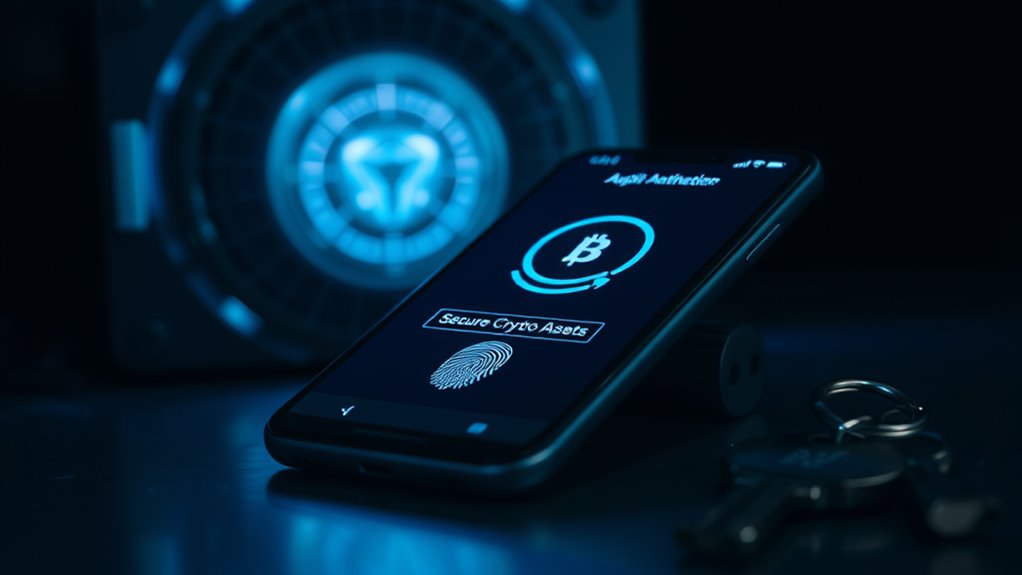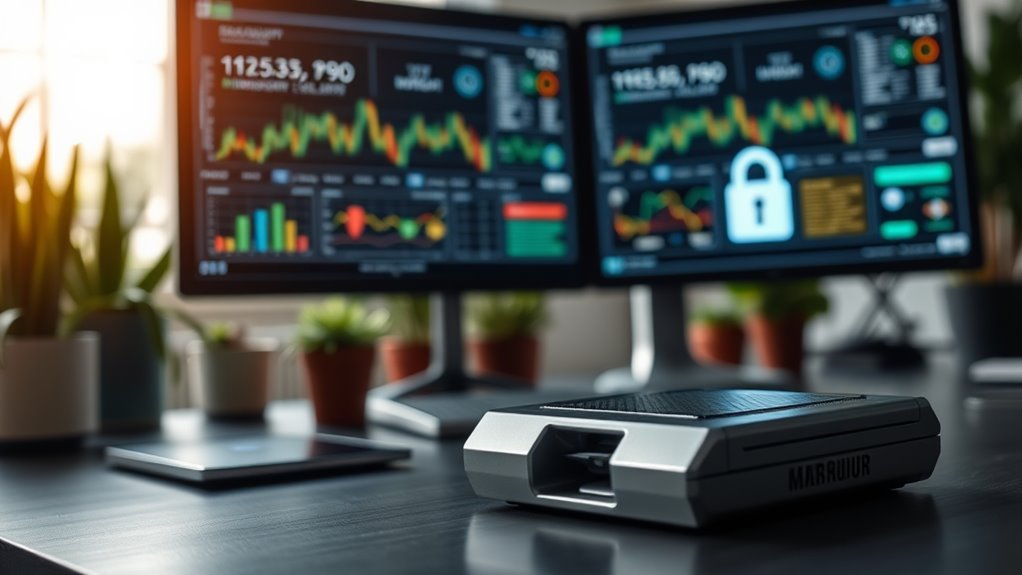
Crypto Exchange Security: Top Measures to Safeguard Assets
Cryptocurrency exchange security requires multiple protective layers. Top safeguards include multi-factor authentication, which blocks 99.9% of automated attacks, and cold storage solutions that keep private keys offline away from hackers. Advanced encryption technologies, real-time monitoring systems, and rigorous KYC/AML procedures form additional defense barriers. Hardware wallets provide an extra security dimension by creating air-gapped protection for private keys. Understanding these measures helps users better evaluate an exchange’s commitment to protecting their digital assets.
Key Takeaways
- Implement robust multi-factor authentication (MFA) across all user accounts to block 99.9% of automated attacks.
- Store the majority of funds in cold storage wallets that keep private keys offline and inaccessible to hackers.
- Deploy advanced encryption technologies including AES-256 and post-quantum cryptographic solutions.
- Maintain real-time threat monitoring systems with AI-powered anomaly detection to flag suspicious activities.
- Conduct regular security audits and smart contract testing to identify vulnerabilities before they can be exploited.
Why Robust Security Protocols Matter in Cryptocurrency Trading

In the rapidly evolving landscape of digital finance, robust security protocols serve as the backbone of cryptocurrency trading platforms. These protocols protect sensitive user data through encryption methods while safeguarding digital assets from potential threats.
Regular security audits identify vulnerabilities before they can be exploited, maintaining compliance with industry standards. For exchanges, implementing these measures isn’t just a technical necessity—it’s essential for reputation management. A single security breach can devastate an exchange’s credibility, resulting in customer exodus and increased regulatory scrutiny.
Security isn’t optional for crypto exchanges—it’s the foundation of trust in an industry where reputation hinges on protection.
Beyond reputation, security protocols directly protect financial assets. Cold storage solutions, network protection systems, and continuous transaction monitoring work together to create an all-encompassing shield against cyber threats. Additionally, secure wallets are crucial for ensuring the safety of users’ digital assets.
Ultimately, the adoption of strong security measures demonstrates an exchange’s commitment to user protection and regulatory compliance.
Multi-Factor Authentication: The First Line of Defense

Despite the sophistication of modern cyber threats, multi-factor authentication (MFA) stands as an essential barrier protecting cryptocurrency users from unauthorized account access. This security measure requires multiple verification methods, combining something known (passwords), something possessed (smartphones), and something inherent (biometrics).
MFA greatly enhances exchange security by blocking 99.9% of automated attacks, according to Microsoft. Users typically enable this feature in account settings, then link authentication apps like Google Authenticator or Authy by scanning a QR code. During login, both credentials and a time-sensitive code are required.
Beyond password protection, MFA effectively counters phishing attempts and prevents account takeovers even when credentials are compromised. For crypto traders, this layered security approach is vital for safeguarding digital assets on exchanges that are frequent targets for hackers. Implementing MFA helps protect against phishing attacks, ensuring that even if a password is stolen, unauthorized access remains highly unlikely.
Cold Storage vs. Hot Wallet Security: Finding the Right Balance

When cryptocurrency users evaluate security options, they face a fundamental choice between maximum protection and operational convenience. Cold storage solutions like hardware wallets offer superior security by keeping private keys offline and inaccessible to hackers, while hot wallets provide easy access for frequent transactions at the cost of increased vulnerability.
- Hardware wallets such as Ledger and Trezor shield assets from online threats while still enabling transactions when needed.
- Paper wallets offer maximum security but sacrifice convenience, making them suitable for long-term holdings only.
- Exchanges with robust security often implement a hybrid approach, keeping most funds in cold storage with minimal amounts in hot wallets.
- Users should consider allocating assets strategically—keeping only necessary amounts in hot wallets while securing the majority in cold storage. A well-balanced strategy involves recognizing the importance of cold vs. hot storage to meet individual security and accessibility needs.
Advanced Encryption Technologies Protecting Your Digital Assets

Modern crypto exchanges implement rigorous end-to-end protection protocols that shield digital assets throughout their entire lifecycle, from deposit to withdrawal.
Leading platforms are investing in post-quantum security solutions to prepare for threats from emerging quantum computing capabilities that could potentially break current encryption methods.
The most secure exchanges employ multi-layered encryption implementation, combining technologies like AES-256 for data at rest, elliptic curve cryptography for transactions, and hardware security modules for key management. Additionally, the integration of artificial intelligence is becoming crucial for enhancing security measures and detecting threats in real-time.
End-to-End Protection Protocols
Every layer of the cryptocurrency exchange ecosystem relies on sophisticated encryption technologies to safeguard digital assets from increasingly advanced threats.
These protection protocols guarantee data remains secure whether at rest or in transit between systems.
- End-to-end encryption creates a secure tunnel between users and exchanges, making intercepted data unreadable to unauthorized parties.
- Secure key exchange mechanisms facilitate the transmission of cryptographic keys without exposing them to potential attackers.
- HTTPS and VPN integration provides multiple encryption layers during data transmission, protecting against man-in-the-middle attacks.
- Cold storage solutions move assets offline entirely, placing them beyond the reach of network-based threats while maintaining accessibility through carefully designed security protocols.
Additionally, implementing best practices such as using strong passwords can significantly enhance the overall security of your digital assets.
These measures work together to create a thorough security framework that preserves both accessibility and protection.
Post-Quantum Security Solutions
While traditional encryption methods provide solid protection for today’s threats, quantum computing‘s emergence has sparked a new security frontier for cryptocurrency exchanges.
As quantum computers could potentially break RSA encryption, exchanges are implementing post-quantum cryptographic solutions to mitigate risks.
Leading platforms are adopting hybrid approaches that combine established encryption with quantum-resistant algorithms.
Lattice-based cryptography, particularly NTRU and Ring-LWE implementations, offers proven security against quantum attacks.
Some exchanges also incorporate multivariate cryptography for digital signatures.
Industry standards are evolving through NIST’s post-quantum algorithm standardization, helping exchanges implement future-proof security measures.
Hardware solutions like specialized security chips further strengthen defenses.
These measures protect against “harvest now, decrypt later” attacks, where malicious actors could store encrypted data today to decrypt when quantum computing matures.
Multi-Layered Encryption Implementation
Leading cryptocurrency exchanges deploy numerous layers of encryption to create virtually impenetrable security architectures for digital asset protection.
These systems utilize AES-256 encryption algorithms alongside end-to-end encryption protocols to secure sensitive data at rest and in transit.
- SSL/TLS protocols establish secure connections between users and exchange servers, preventing man-in-the-middle attacks that could compromise transaction integrity.
- Public key infrastructure (PKI) systems authenticate users and devices, ensuring only authorized parties can access accounts.
- Digital signatures verify transaction authenticity, making it nearly impossible for attackers to forge trading instructions.
- Cryptographic hash functions maintain data integrity by creating unique fingerprints for transactions that immediately reveal any tampering attempts.
These encryption layers work in concert with other security measures like multi-factor authentication, creating extensive protection against evolving threats. Additionally, employing rigorous testing and auditing before deployment can further safeguard against vulnerabilities in smart contracts.
KYC and AML Compliance: Necessary Safeguards Against Fraud

As cryptocurrency exchanges continue to grow in popularity, Know Your Customer (KYC) and Anti-Money Laundering (AML) procedures have become critical safeguards within the digital asset ecosystem. These protocols verify user identities and monitor transactions to prevent illicit activities.
Regulatory frameworks in the U.S., EU, and many other jurisdictions mandate these compliance measures for crypto businesses. While implementation challenges exist—including increased operational costs, potential user friction, and privacy concerns—the consequences of non-compliance are severe, ranging from substantial fines to complete business closure.
Modern exchanges increasingly leverage automated solutions and AI-driven technologies to streamline verification processes while maintaining security. These technical innovations help balance regulatory requirements with user experience, creating safer trading environments without sacrificing efficiency. As the landscape evolves, regulatory frameworks are adapting to focus more on consumer protection and innovation, further emphasizing the importance of KYC and AML compliance.
Real-Time Threat Monitoring and Detection Systems

Crypto exchanges deploy advanced AI systems that continuously analyze transaction patterns to detect anomalies and potential threats in real time.
These monitoring systems can identify cross-exchange fraud patterns, revealing sophisticated attacks that span multiple platforms and would otherwise remain hidden.
Security teams also implement honeypot strategies, creating deliberately vulnerable decoy systems that attract and trap attackers, allowing exchange operators to study attack methodologies while keeping genuine assets secure.
Automated AI Anomaly Detection
Modern cryptocurrency exchanges increasingly rely on sophisticated AI-driven systems to defend against evolving threats. These systems continuously analyze vast datasets using machine learning algorithms that can identify unusual patterns and potential security risks before they escalate into major breaches.
- Real-time detection flags suspicious activities within milliseconds, allowing security teams to respond before asset theft occurs.
- Predictive capabilities anticipate emerging attack vectors by analyzing historical data and identifying new threat patterns.
- Behavioral analysis monitors user actions to identify deviations from normal patterns, catching account compromises.
- Automated response immediately restricts suspicious transactions until verification, minimizing potential damage.
These AI anomaly detection systems incorporate both supervised and unsupervised learning approaches, enabling exchanges to protect customer assets from both known threats and novel attack strategies that traditional security measures might miss. Additionally, utilizing a VPN for crypto security can further enhance the protection of user data and transactions against potential cyber threats.
Cross-Exchange Fraud Patterns
Sophisticated criminal networks have developed intricate schemes that exploit vulnerabilities across multiple cryptocurrency platforms simultaneously, creating complex fraud patterns that traditional security systems struggle to detect. These activities include “pig butchering” scams where victims are lured into bogus trading platforms, identity fraud using synthetic identities to bypass KYC controls, and cross-chain coin swaps that obfuscate the origin of illicit funds. Notably, incidents like the Poly Network hack illustrate the importance of robust security measures in the cryptocurrency space.
| Fraud Type | Method | Detection Approach |
|---|---|---|
| Pig Butchering | Fake investment platforms | Behavior analysis & risk scoring |
| Identity Fraud | Synthetic identities | Advanced KYC verification |
| Dark Web Laundering | Cross-chain transfers | Cross-platform tracking tools |
Real-time transaction monitoring and cross-platform tracking technologies have proven essential in identifying these complex patterns. Systems like Coinpath API allow security teams to trace fund flows across multiple blockchains, creating thorough visibility into potentially fraudulent activities.
Honeypots Trap Attackers
While cross-exchange fraud patterns present significant challenges, proactive security measures provide an effective counterstrategy through specialized honeypot systems.
These systems deploy decoy smart contracts that mimic vulnerabilities, attracting potential attackers while simultaneously monitoring their behavior to strengthen overall security.
Real-time threat monitoring systems deliver four key benefits:
- Immediate threat detection through continuous observation of all honeypot interactions
- Valuable intelligence gathering on attacker methodologies and targets
- Enhanced response capabilities through automated alert systems when suspicious activities occur
- Adaptive defense improvement as collected data informs security upgrades
Additionally, implementing strong passphrases for private key encryption can significantly enhance the protection of digital assets.
When integrated with regular security audits and robust authentication protocols, honeypot systems represent a critical layer in thorough exchange security architecture, allowing security teams to stay ahead of evolving threats.
The Role of Hardware Wallets in Exchange Security Architecture

Hardware wallets represent a critical component in the security infrastructure of modern cryptocurrency exchanges. These specialized devices store private keys offline, creating an air-gapped barrier against online threats while enabling secure transaction signing without exposing sensitive data.
Many exchanges now integrate hardware wallet functionality, allowing users to trade directly from their cold storage rather than transferring assets to hot wallets. This arrangement considerably reduces the attack surface by minimizing the amount of cryptocurrency held in more vulnerable online environments.
Cold storage trading integration dramatically reduces cryptocurrency vulnerability by keeping assets offline until transaction execution
When properly implemented, hardware wallets guarantee private keys remain inaccessible to the exchange itself, creating a trustless model that protects both parties.
For maximum security, exchanges often employ hardware wallets with firmware validation and regular security updates while maintaining strict physical security protocols for both devices and recovery phrases.
Preparing for Tomorrow: Post-Quantum Cryptography and Emerging Threats

Beyond hardware-based defenses, the looming reality of quantum computing poses unprecedented challenges to cryptocurrency exchange security. Current encryption methods like RSA and ECC face potential obsolescence as quantum computers advance, making post-quantum cryptography essential for long-term protection.
- Harvest now, decrypt later tactics threaten today’s encrypted data, which can be stored until quantum decryption becomes viable.
- Blockchain vulnerabilities could undermine both Proof-of-Work and Proof-of-Stake systems, destabilizing entire DeFi ecosystems.
- Hybrid encryption approaches combining traditional and quantum-resistant algorithms offer the most robust adaptation strategy.
- Crypto agility enables exchanges to adapt security protocols without operational disruption as standards evolve.
Emerging solutions include quantum-resistant chips, lattice-based algorithms, and NIST-standardized cryptographic methods that exchanges must proactively implement to safeguard assets.
Frequently Asked Questions
How Are Insurance Policies Implemented for Crypto Exchange Asset Protection?
Insurance policies for crypto exchanges are implemented through customized coverage for cyber threats and thefts, funded by user fees and exchange profits, with ongoing risk assessments to adapt to evolving threats.
What Happens to My Assets if the Exchange Goes Bankrupt?
If an exchange declares bankruptcy, customer assets may be classified as property of the estate or customer property. Unsecured creditors typically recover only a fraction of investments and face lengthy delays during bankruptcy proceedings.
Can Exchanges Recover Stolen Crypto After a Security Breach?
Where there’s a will, there’s a way. Exchanges can recover stolen crypto through blockchain forensics, collaboration with law enforcement, and legal action, though success depends on response time and the hacker’s sophistication.
How Do Exchanges Secure Assets During System Maintenance Periods?
During system maintenance, exchanges employ network segmentation, system isolation from the internet, advanced encryption, multi-layer authentication, and regular backups. Physical security measures and strict access controls further safeguard assets throughout maintenance periods.
What Security Differences Exist Between Centralized and Decentralized Exchanges?
Centralized exchanges employ KYC and robust security protocols under single-entity control but risk large-scale hacks, while decentralized exchanges offer non-custodial models with user-controlled assets, enhancing privacy but facing smart contract vulnerabilities instead.
Conclusion
As cryptocurrency markets evolve, exchanges must continuously fortify their defenses against increasingly sophisticated threats. Like knights guarding a digital fortress, these security measures work together to protect valuable assets while maintaining accessibility and functionality. By implementing robust protocols from multi-factor authentication to cold storage solutions, exchanges can provide users with both confidence and security in an ecosystem where trust remains the ultimate currency.












